ASUS G73SW + SNB: Third Time’s the Charm?
by Jarred Walton on March 4, 2011 12:00 AM ESTApplication Performance: Plenty Fast
We’ll start with our standard set of application results. Here’s where the Sandy Bridge processor upgrade really helps the G73SW distance itself from the previous iteration. What would help even more would be to get an SSD in the system as the OS/app drive; even a 60GB model would be fine, but personally I find 120GB to be the sweet spot. The main comparison here is going to be with the MSI GT680R and the older G73JW, although the Clevo P170HM is also worth a look. As the unit we tested had an SSD, the P170HM is going to really pull ahead in the PCMark tests.
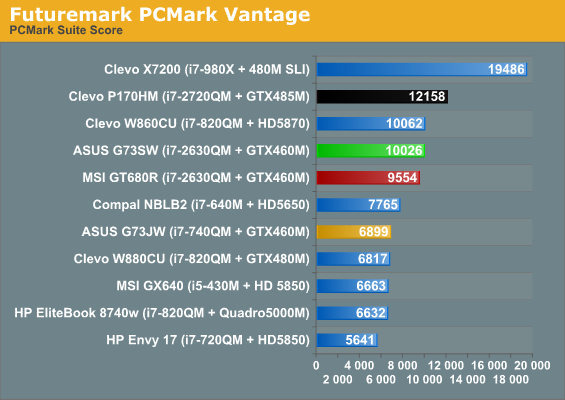
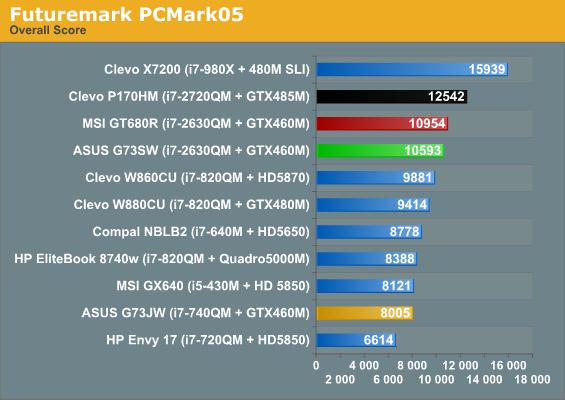
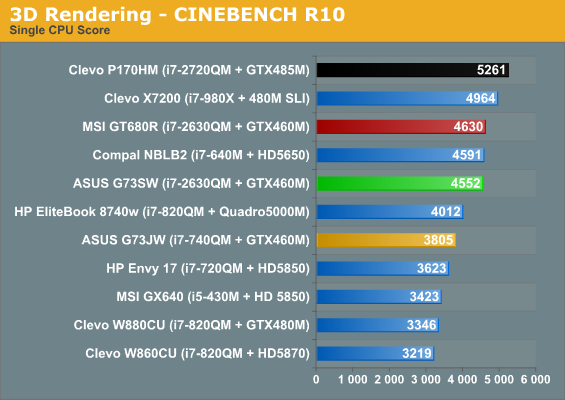
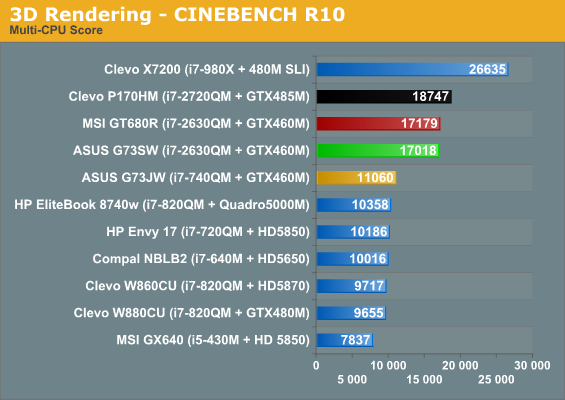
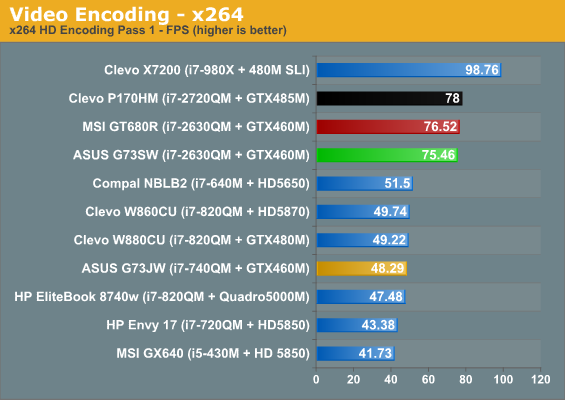
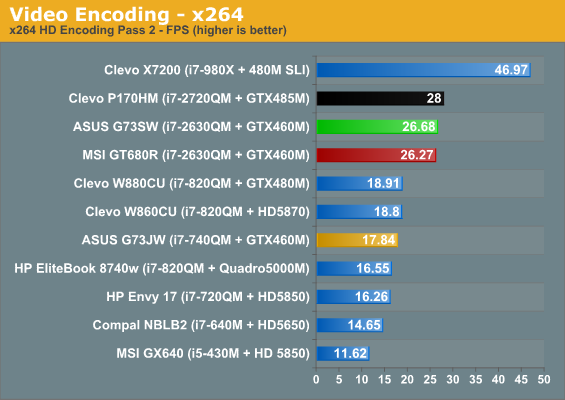
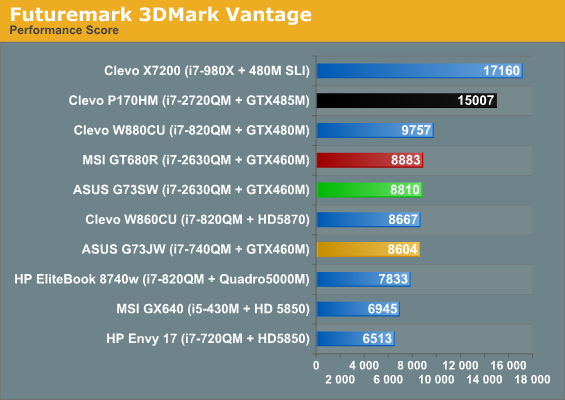

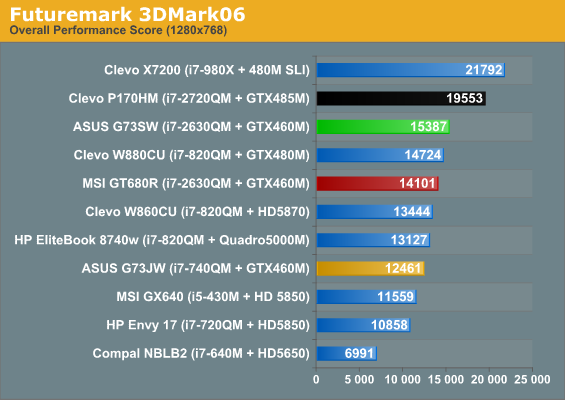
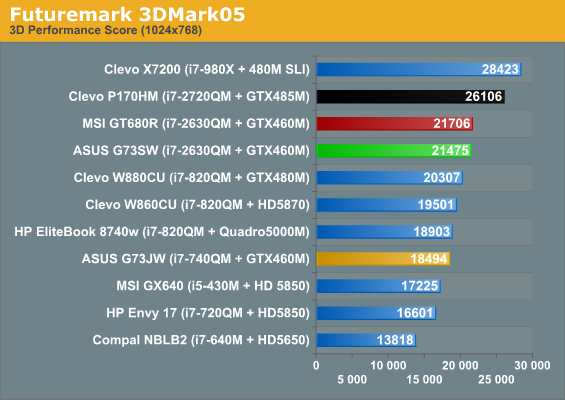
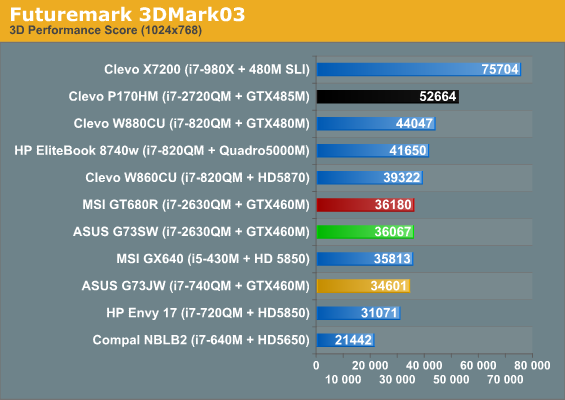
So the first point of interest is just how much faster the G73SW is compared to the G73JW. It leads by 45% in PCMark Vantage (and that’s without an SSD), 32% in the older PCMark05, and anywhere from 20% in the single-threaded Cinebench results to as much as 58% in the multi-threaded tests. In fact, all of the heavily threaded benchmarks are at least 50% faster with Sandy Bridge. Wow. But we already knew that. What about some more recent competition?
MSI’s GT680R has pretty much the same specs, only with RAID0 HDDs instead of individual drives. Oddly enough, the G73SW still came out slightly ahead in PCMark Vantage (by 5%), a test that’s particularly kind to fast storage subsystems (particularly SSDs). PCMark05 puts the GT680R ahead by a similar margin (3.5%), but Vantage is arguably more pertinent in today’s market. Elsewhere, the comparison is largely a wash, with MSI winning three, ASUS winning two, and a tie in the final test. All of the margins of victory are close enough to call it a tie. So, despite having a larger (and ostensibly cooler running) chassis, the G73SW delivers about the same performance as that of the GT680R, which is still very good.
The other point of comparison is the recent Clevo P170HM, which has a faster i7-2720QM CPU and a much faster GTX 485M GPU. The latter mostly won’t matter here (except for PCMark05), but the 2720QM does carry a small clock speed advantage, and the Crucial C300 SSD will definitely help in PCMark Vantage—good for a 21% lead, in fact. it has an 18% lead in PCMark05, with help from both the SSD and GPU. The remaining tests are purely CPU limited, and the lead ranges from 3-5% in x264 encoding to as much as 15% in the single-threaded Cinebench result where the more aggressive Turbo Boost on the 2720QM comes into play.
Recall that the 2720QM can Turbo to 3.3GHz from the stock 2.2GHz for single-threaded work, and still hit as high as 3.0GHz with all four cores active; in contrast, the 2630QM maxes out at 2.9GHz single-threaded, or 2.6GHz for all four cores. It looks as though x264 encoding isn’t able to Turbo as high as Cinebench for some reason, as even the heavily CPU bottlenecked second pass is still only 5% faster with the 2720QM, despite a potential 10% to 15% clock speed advantage—or maybe it’s that the G73SW is able to run at the maximum 2.6GHz, whereas the P170HM might have to drop down to 2.7-2.8GHz due to temperature.
Any way you slice it, the quad-core Sandy Bridge processors are very fast for general computing work. It’s just a shame that the use of the PM67 chipset and discrete GPU means there’s no way to access the CPU’s QuickSync feature. That’s one more reason switchable graphics really makes sense in notebooks, but it does add some complexity that some of the OEMs prefer to avoid. So far, no one has been willing to try NVIDIA’s Optimus Technology with any mobile GPU faster than the GT 435M, although we hear there’s a GT 555M Optimus notebook coming some time in 1H’11.










56 Comments
View All Comments
7Enigma - Friday, March 4, 2011 - link
Turbo negates much of your comment.bennyg - Monday, March 7, 2011 - link
Good thing designers don't just ask you for your opinion and consider what others use.8Gb is not pointless, I run up against the limits of 4Gb all the time.
Granted, some dualcore arrandales were better than clarksfields were better than the quadcores, but:
1) this is comparing highest-end dual core vs lowest-end quad (i7 620M approx i7 720qm). Higher clocked quads esp. the XMs were still faster than the arrandales.
2) clarksfield was not a native mobile chip, it was a downclocked undervolted lynnfield released many months before
3) the total *work* which the quad cores can do is higher, the issue is optimisation of workloads, in particular games are pretty bad at using a 3rd and 4th core, and especially so when Turbo means that 3rd and 4th core use come at a clockspeed disadvantage if you want to think of it that way. I.E. the quad is slower because software doesn't use it well enough
4) the usage patterns and power of the i7 quads could be much better utilised but Intel locked all the Turbo logic away on-die except for the XMs. Meaning overclocking a QM can actually *decrease* performance due to preset limits causing less Turbo-ing. Hell, the BIOS in my laptop has absolutely nothing, I can't even disable hyperthreading - to reallocate more of the supposedly "unified" L3 to each core...
There is *so* much more the quads could have offered but tweakability was hugely reduced compared with the C2D/Qs.
bennyg - Monday, March 7, 2011 - link
bleh no edit featureOf course the point I missed (along with all the typos) was that we are now in the era of Sandy Bridge and "Turboboost 2.0", Nehalem and Turboboost is old news, and so are the opinions based off it.
DanNeely - Friday, March 4, 2011 - link
Depends how hard you use your system. My work laptop with MSSQL and VIsual Studio 2010 running in addition to the normal set of office apps regularly uses 5-6GB of memory. My heavily used destop (I7-930) is currently sitting at 12GB used (~10GB excluding BOINC).DooDoo22 - Friday, March 4, 2011 - link
Please include comparisons to the new MBPs in your next laptop review. It is easier to judge the relative merits of these dime-store versions when we have a reference model like the MBP.laytoncy - Friday, March 4, 2011 - link
How does the GT 555M 3GB that is in the new XPS 17" from Dell stack up to the 460M or GTX485M?Kaboose - Friday, March 4, 2011 - link
To my knowledge the GT 555m is the GT 445m clocked higher, here is a quote from notebookcheck"We tested the gaming performance of the GeForce GT 555M with DDR3 graphics memory in a pre sample of the Dell XPS 17. The synthetic benchmarks show a performance slightly above the old GeForce 9800M GT. GDDR5 versions should be slightly faster. Therefore, nearly all current demanding games should run fluently in 1366x768 and high detail settings. Only extremely demanding games like Metro 2033 will only run in medium detail settings. Older and low demanding games like Fifa 11 should run in high detail settings and Full HD resolution"
This is what they had to say about the GTX 460m
"We ran a set of benchmarks on an early pre-sample of a Qosmio X500 with a 740QM CPU. In the synthetic benchmarks, the GTX 460M was on par with the DDR3 based Mobility Radeon HD 5850. In actual game benchmarks and tests, the performance was better than a HD 5850 with GDDR5 on average. In some cases (e.g., Unigine Heaven 2.1 and Dirt 2 Demo), the card even beat a Mobility Radeon HD 5870. On average, the GF100 based GTX 480M was about 8-18% faster. The detailled benchmark and gaming results (including charts) can be found below"
So they arent really very close in performance the GT 540m is the low end gaming the GT 555m is a step in the right direction but not into the "gaming" area yet.
rscoot - Friday, March 4, 2011 - link
Playing a little bit of guitar before you wrote this article Jarred? :PJarredWalton - Friday, March 4, 2011 - link
Whoops... Freudian slip or something. ;)Pessimism - Friday, March 4, 2011 - link
chord != cord